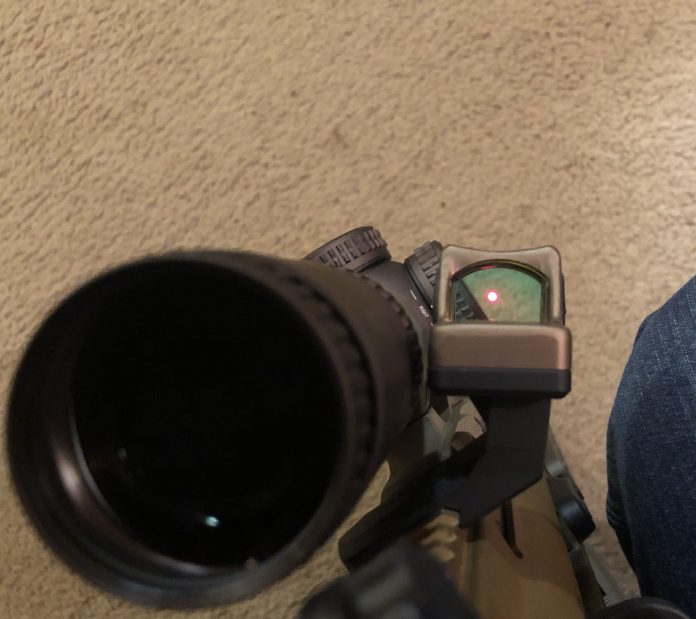
I’ve spent a substantial amount of time hitting Low Power Variable Optic systems recently and have been neglecting dot optics. This isn’t deliberate, it is much more a reaction to developing tech, trends, and selections.
What do I mean?
All the Armed Forces branches are going with an LPVO, the NGSW-FC is an LPVO, most optic companies hottest optics are their latest LPVO (See PA and EOtech), and I am an absolute LPVO convert. Most of my rifles run variables.
Why? A combination of astigmatism and my love of what the ACOG gave me for downrange information. This while acknowledging that the red dot and quick 1x aiming is a helluva good deal. The ability for a shooter to identify a circumstance they want to extend distance and focus their sight picture is valuable, but the ability to accurately and reflexively snap onto a target you can identify as needing to be shot with the good ole eyeballs is probably the more critical function.
The red dot covers that base function in spades.
The red dot is the iron sight perfected, a precise aiming point that is equally precisely aligned to the weapon it is mounted on. This removes a tremendous amount of the subjective error from the shooter’s perspective. You aren’t too close or too far away from a red dot. Your head isn’t too high or too low. Your front sight isn’t 12-18 MOA, it is 2 MOA. You can see all directions around the dot. Your firearm doesn’t occlude part or most of the target with its sight.
So many things support the dot’s excellence and it has few limitations. Only one really, the human eye, which is also a limit to using any ocular device, including irons and scopes.
If the eye in your head cannot interact with the dot, due to malformations or injuries, then a dot won’t help you. A doctor can probably fix that though. Probably. I know a few shooters who are now bound to solid state optics like ACOGs, LPVOs, etc. because of the condition of their eyes.
Getting old sucks. Getting injured sucks. We adapt as best we can.
Anyway, time to show some love to the dots.
Romeo8T – Sig Sauer

If I were asked what my favorite red dot is, the quick, casual, and without further context answer would be the Romeo8T.
This large frame box optic with it’s futuristic good looks combines features of two other highly recommend sights into one. The Aimpoint CompM5 has tremendous durability and extreme battery life. The EOTech XPS and EXPS series have wide open windows for easy acquisition and exceptional clarity.
The Romeo8T is basically a, “Both? Both. Both is good.” design that took the strengths of dot efficiency and put them in a housing that gave you the EOTech advantages. Then they gave you selectable reticle control, easy on/off and brightness adjust, and made armorers jobs easier with repairs on the crush shroud. The shroud takes the damage, replace the shroud instead of replace the whole optic, and the optic can operate fine without the shroud if needed.
Additionally it is NVG compatible and the large window makes passive aiming much less of a pain. Additionally to that additionally the battery life is something like 3 to 9 years depending on setting and reticle selected, mine is at three years on the single dot setting and just being turned up or down for the visible light conditions. If you’re using any of the normal battery disciplines this optic will never turn off unless you tell it to.
On a personal note and for those with astigmatism, the Sig LED emitters work sharply with my eyes, where both Trijicon and Aimpoints tend to flare more.
The Romeo8T’s primary limitation is its size. It’s on the larger and heavier end of dot optics, funny enough that’s how you get large optic windows. It also can’t get lower on an optic rail than standard M4 offset ~38/39mm with the integral base. This will make it ideal on some rifles/mounts and unusable on a few others. Anything with an M4 optics layout can utilize the Romeo8T to full advantage.
CompM5 – Aimpoint
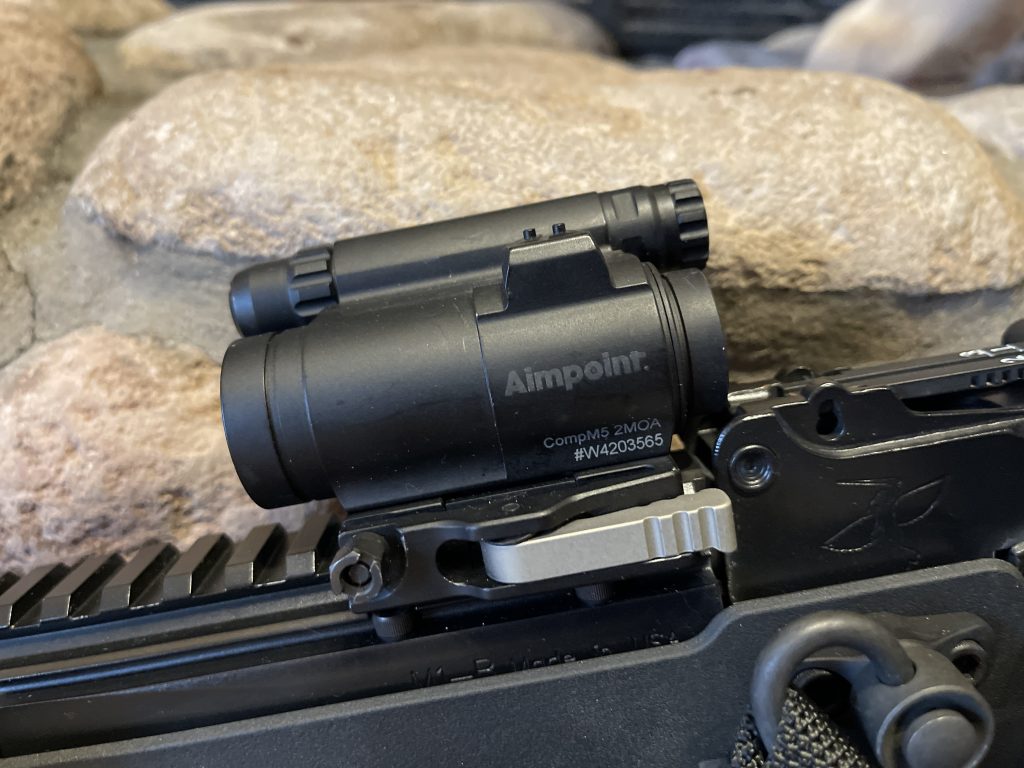
No surprise, I like the most expensive dot optic on the market. Go figure, it’s built well.
The CompM5 is my favorite T1/T2 pattern small dot. It is also my favorite ‘universal use’ dot, since T1/T2 base compatibility and the ability to mount flush allows it to go more places and do more things than the above mentioned Romeo8T. The only thing I’ve lost, realistically, is window size (and selectable reticle if you like that feature).
I will again mention that, for my eyes, Aimpoint emitters flare more than Sig and Holosun emitters. That doesn’t notably impact my ability to run any gun I have put this on.
It runs off of AAA’s. Why is this good? Battery cell AAA’s are still a more prevalent battery cell than CR123’s and rechargeable 18350 types, especially internationally for anyone poking around less than western locales. Here they remain a super easy battery to get inexpensively and in bulk. Optic dead at class or a match and you didn’t bring spares already? (*shame meme of choice goes here*) Simply go to anywhere that sells almost anything but fast food and you have found batteries.

The CompM5’s greatest strength beyond the earlier CompM series’ is its ability to low mount. This allows it to go all the places a red dot belongs short of pistol slides (though I haven’t tried a Balor, it might work).
In fact, it’s that low mount ability that baffles me on why they brought out the CompM5s. I have a CompM5s too, but we go back to the M4 optic suite height restrictions for no reason. It made sense on the CompM4 as that was bound to a base, moving the battery around low in the CompM4s didn’t change the height or size profile much from the CompM4. It protected the battery a little more so it was a net design gain. The CompM5 wasn’t mount/base restricted and they built a new version with the CompM5s that was restricted.
Aimpoint also built one that was 100, 200, 300 meter range adjustable though so… build what your customer wants does still apply.
Anyhow, the CompM5 is arguably the most durable and flexible dot on the market. Top option for many applications.
Sidebar: Zeroing Dots
Let’s talk about zeroing really quick. We’ll also hit on why the 100, 200, 300 Aimpoint is kinda weird. Not wrong weird, just.. weird.
You may also notice I’m not really specifying yards/meters. Is there a difference? Yes. Does it matter in live fire terms for the 0-300 shooting? Much less. I’ll get to that too.
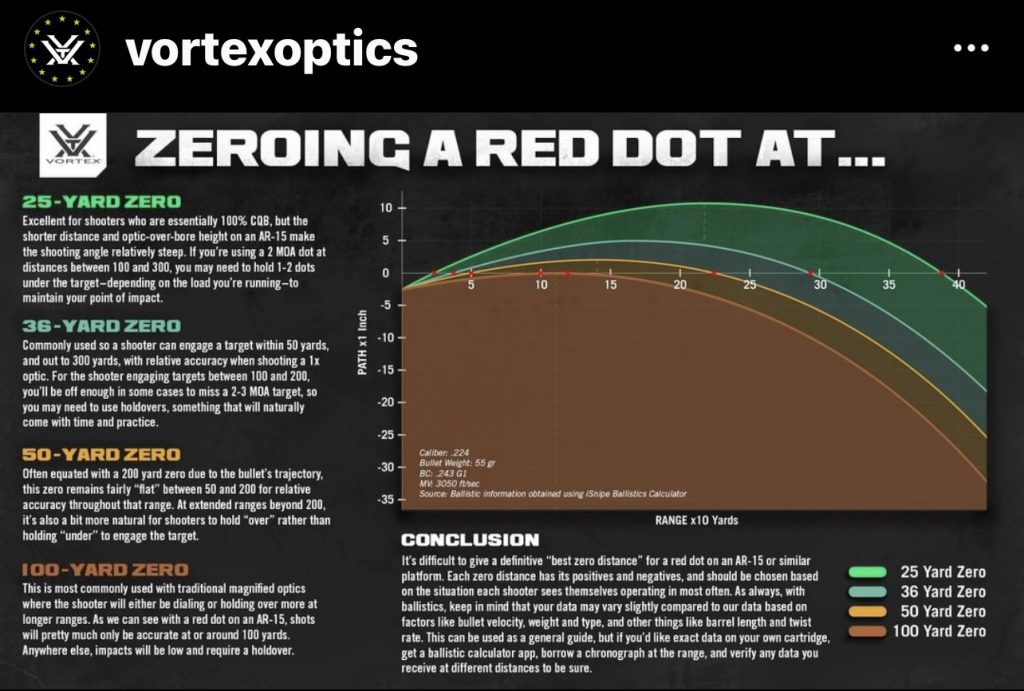
The Vortex graphic does an excellent job of summing up zeroes at various distances. Keep in mind that as the optics height over the barrel increases or decreases, the trajectory angles change too.
A 50 yard dot zero on an AR is not the same as a SCAR or X95, but in general real world effects, close enough really is close enough. You can always shoot live to confirm the POI. Alternatively, like Vortex did here, put the info into a ballistic app with accurate optic height, BC of your ammo, and its muzzle velocity and you’ll see your trajectory more than well enough for carbine work.
In my considered opinion (worth exactly what you paid for it) 50 is a fantastic universal rifle zero distance for dots, especially if you use the bottom of the dot as your point of aim and allow the round to travel up through the 2 to 4 MOA dot. This gives you a relatively flat trajectory that never stops ‘touching’ the dot. Unless you are very close to your target or beyond 200 yards, for most rifles and calibers, you hold on the target to get a hit.
After 200, starting to hold high but still on the target comes into play which is a natural act and makes sense to new shooters. The US Army’s ‘belt buckle’ zeros of having soldiers hold low for intermediate distances has always struck me as unnatural and counterintuitive.
So let’s take an extreme case example.
It’s a good day, but you have to use your AK. It’s a 7.62×39 with a 2 MOA dot on it. You have a 50 yard zero. But you have a target at 300 meters.
Oh no! What do you do!?!
Hold an extra dot’s height high and send it, again if necessary. The difference between 300 yards and 300 meters is ~2 MOA of additional hold over, or about 7″.
Are you going to easily pull off a 1-for-1 headshot with this setup? No. Not it’s job. But you could body someone threatening you and yours, with just the dot on threat, over and over, with ease. It is reflexive and easily taught, even if you don’t have the time to explain concepts like trajectory and external ballistics in detail.
Just about any rifle. Just about any dot. Zero at 50. Tell them to aim at the chest. If the threat is really far, aim at the head or just above. Conscript level simplicity for conscript level problems. Or put another way, Home/Civil Defense level simplicity for home/civil defense level problems.
“But Keith, if I’m defending my house wouldn’t a real short zero make sense?”

The short zero argument is a case of picking your problem. You have a problem no matter what you do. You either have an extreme ballistic arc on your round that will make anything in the 50-300 zone weird to shoot at (even with a 25 zero, but we’re talking something like a 7 or 10, super close), or you have to train to hold high on close targets.
With a longer distance zero this problem is a simpler pattern recognition with fewer negative consequences. Need to face shoot, your aim point is to give the threat a haircut. Your height over bore offset, and therefore error, up close will only ever be up to the distance between your optic center and your barrel center, and the further you get the more it closes up until your zero distance.
So for that proverbial “hostage rescue headshot” scenario, where the miss low has tragic consequences, is it easier to guess the precise distance you will be making that shot at extreme close range? Keep in mind that if you are closer than your pre-guessed zero distance you are back to the same problem of needing to hold over, and if you are further now your round is arcing high. Or, is it easier to train and pattern recognize that if you’re close hold high, upwards of 4″, and the bullet is going to meet target somewhere in that space.
Hint: It’s the second one. Close quarters optical offset is pretty easy to learn, and anyone who doesn’t know it shouldn’t be confident taking “hostage rescue” shots anyway.
End Sidebar: Back to dots
The Handgun Reflex Sight – Trijicon RMR RM06-HRS
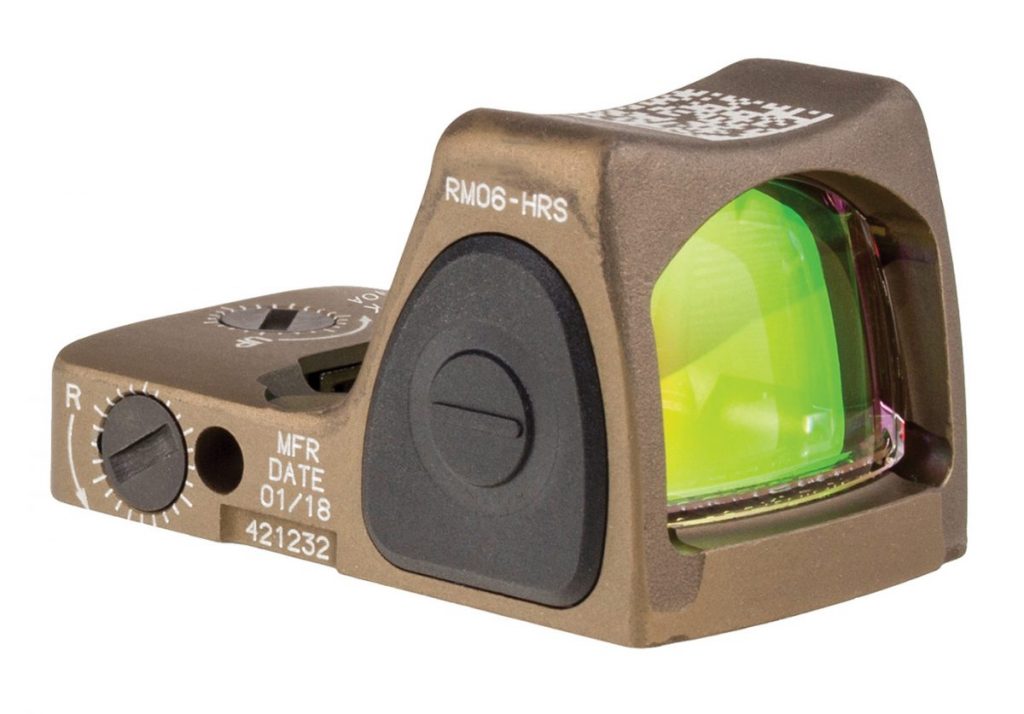
Of course the RMR made the list. The specific model though, for a reason counter to its name.
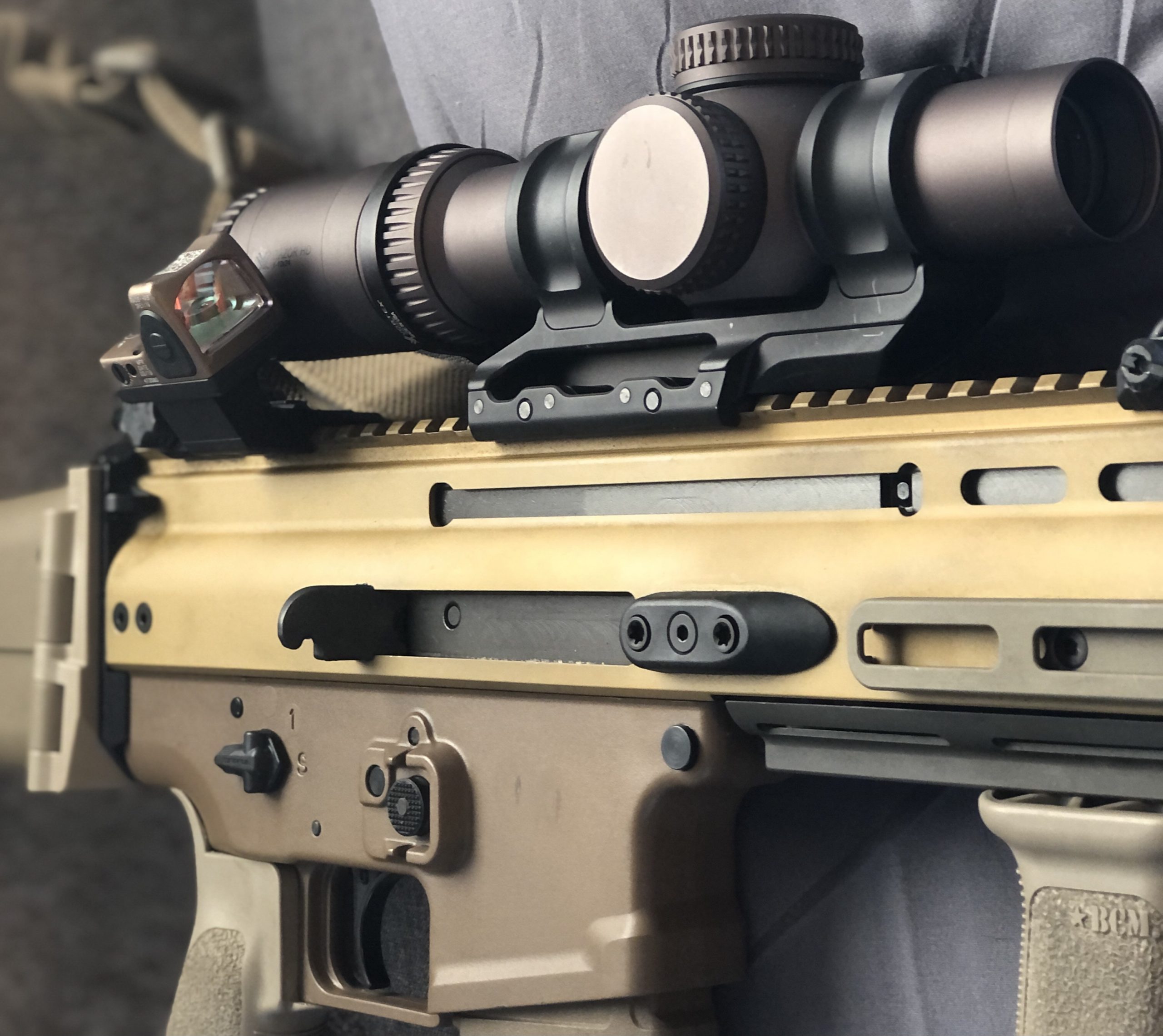
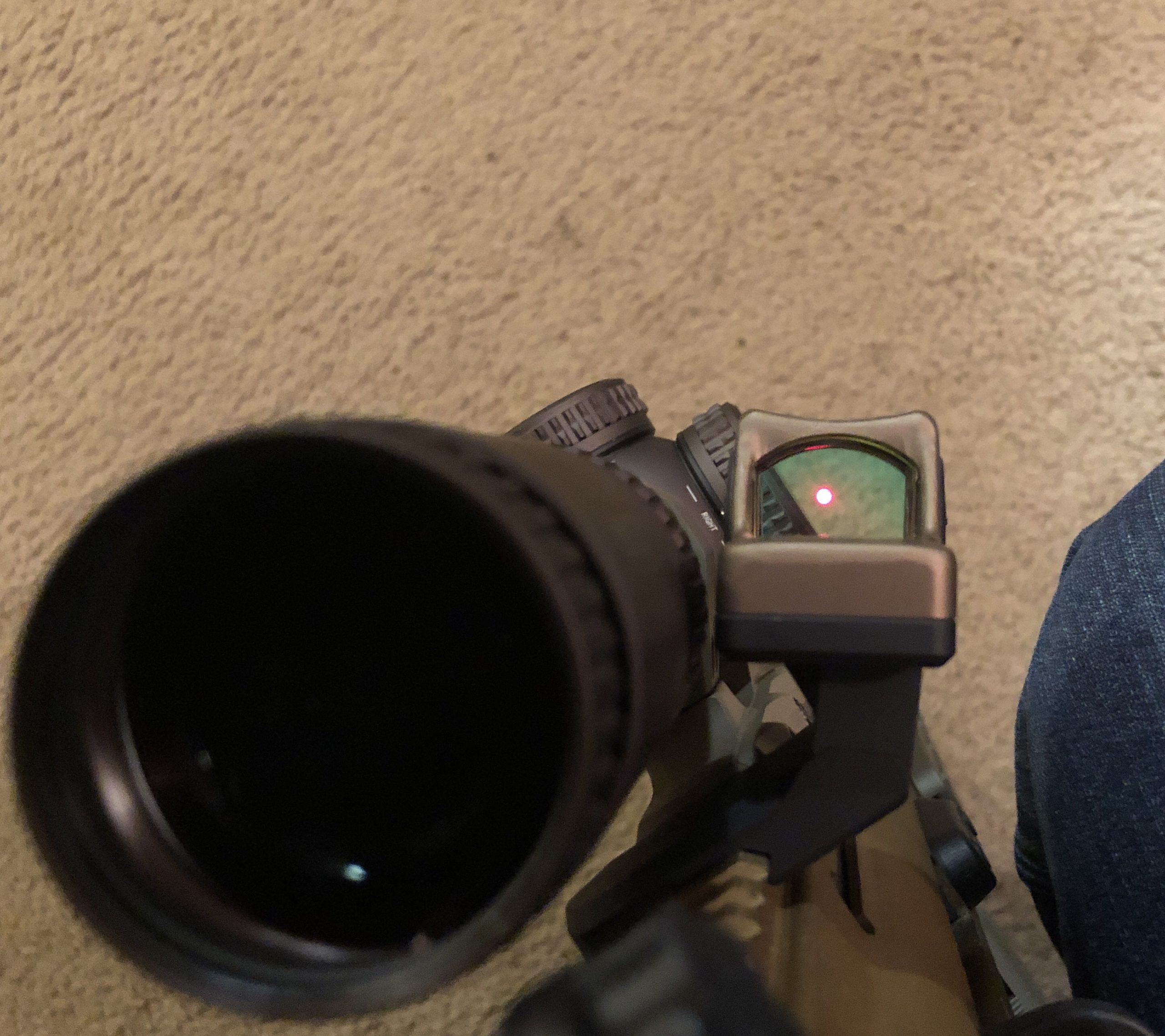
I like the HRS best as an offset rifle sight with, you guessed it, a 50 yard zero.
Why?
This specific sight’s mode of operation and the general durability of the RMR make it excellent is this non-namesake role.
Now we can have the open emitter/closed emitter argument another time. I personally like the RMR, open emitter and all, and if a karmic snowflake or a raindrop gets me kilt-in-da-streetz then that’s how I go. Congrats to whoever gets my SCAR as loot during the Madmaxian Dystopia adventure times.
Back to the RM06-HRS. The RM06 isn’t new, but the HRS is a special variant that has both an auto power down (not off) feature and a specified anodizing instead of cerakote (mil contract requirements). The former makes it particularly useful in the rifle role, in my opinion.
The feature, which can be locked into use, has the RMR auto-adjusting for ambient brightness. This feature is a hallmark of Trijicon optics and available on many competing options. The HRS can additionally be, at will, manually adjusted by the user to a desired brightness and it will stay there for 16.5 hours from the last adjustment. It then reverts to its power saving ambient mode.
Why do I like this in a rifle optic more than a handgun one? Because I check my handgun optic every day that I carry it, I make minor adjustments for lighting conditions if necessary. I don’t check my rifle daily, it just sits there leaning in the rack waiting to be used. What the feature gives me is a very high degree of probability that, when I grab the rifle, the dot is properly adjusted for the current light and I can take an immediate shot. I can also, with a small amount of time to do the once over on my gear, lock in an illumination setting I am comfortable with, that will stay with me for 16.5 hours, as I also check light, primary optic, and all my other knick knacks that help keep me alive.
It’s a respectably sized 3.25 MOA dot for reflexive work and has a good year+ of battery in active use.
The HRS’s limitations are two, the lens has a pretty heavy tint which also causes a small magnifying effect and the battery is stored under the optic. The first isn’t bad unless you are using another piece of gear, like eyewear, that cause a compatibility issue. The second is only an issue if at battery swap time you don’t have the tools on hand to perform it properly with proper non-permanent thread locker, torque, and a zero re-check.
It does make a very suitable handgun optic, hence the name, and I might make that change one day. I honestly like it best as a supporting rifle optic to a scope though.
Holosun 507/508
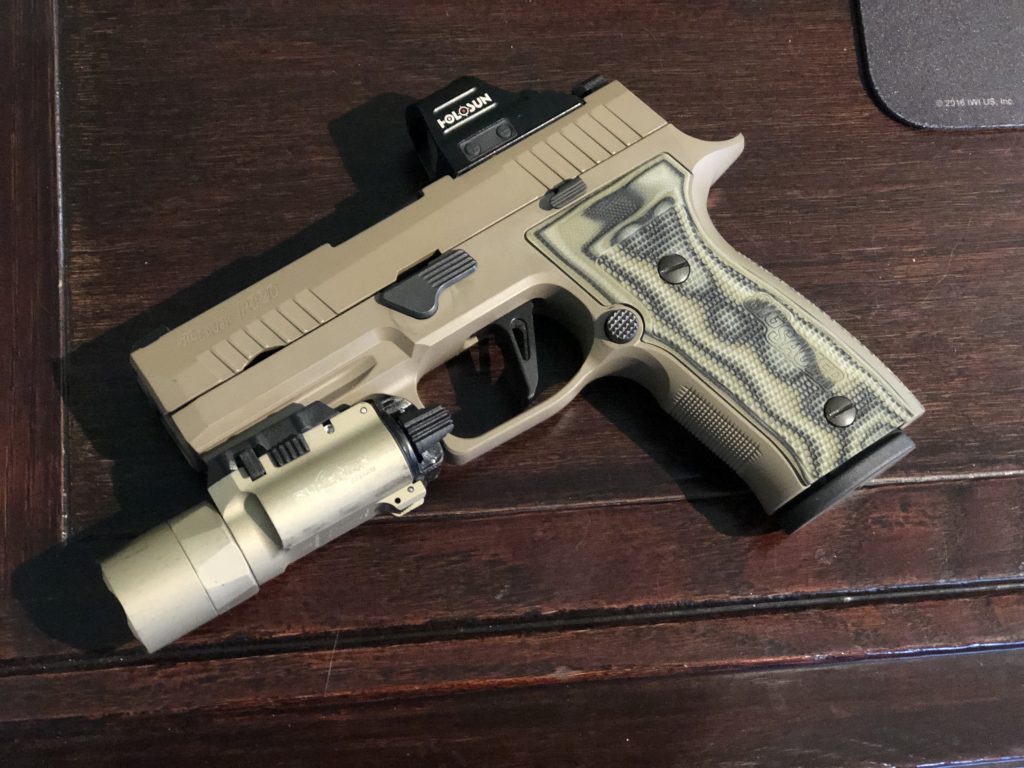
Say what you may about where they are made, Holosun’s design team and customer service team here in the states have listened and acted on the requests of their customer base to produce desirable optics at desirable prices, and they have endured.
They were so good that Trijicon leveled a very publicly unpopular lawsuit against Holosun that made them change the buttons and name of the Gen2’s to X2’s. It seemed to be one of the classic cases of a company hitting back against another’s successes in a petulant manner instead of putting their heads down and competing.
The 507/508 take my preferred pistol optic position, 507k for the smaller pistols with optics. They strike the right balance in many categories. Price, clarity, durability, maintenance cycle requirements (battery), and optic window.
The main reason I am running Holosun on my pistols, and not HRS, is the window. I simply like how I find the dot in a Holosun better than the HRS during a pistol presentation. I additionally like the lens coatings, clarity, and emitter clarity better in the Holosun. I know it lacks in the upper level durability, but testing has shown it retains zero well, even with damage. Not the most durable, but durable enough.
What these optics are best at is being an everyman’s dot. It is going to cost some, but not as much. The 508T runs about $200 less on Amazon than the HRS. Neither are absurd in cost, but $200 is $200 and the feature sets for the role are comparable. The Holosun’s is a little less chaotic with manual brightness, auto brightness, and preferred reticle being selectable by the user with no auto-revert function. The HRS has no option for manual only, just manual with reversion or locked auto. The battery in the Holosun side replaceable, no removal of the optic, retorque, and re-zero required.
All things considered, this is the pistol dot for those needing a “good dot” but not the particular specifications of something like the HRS or ACRO P-2.
EOTech EXPS 2/3
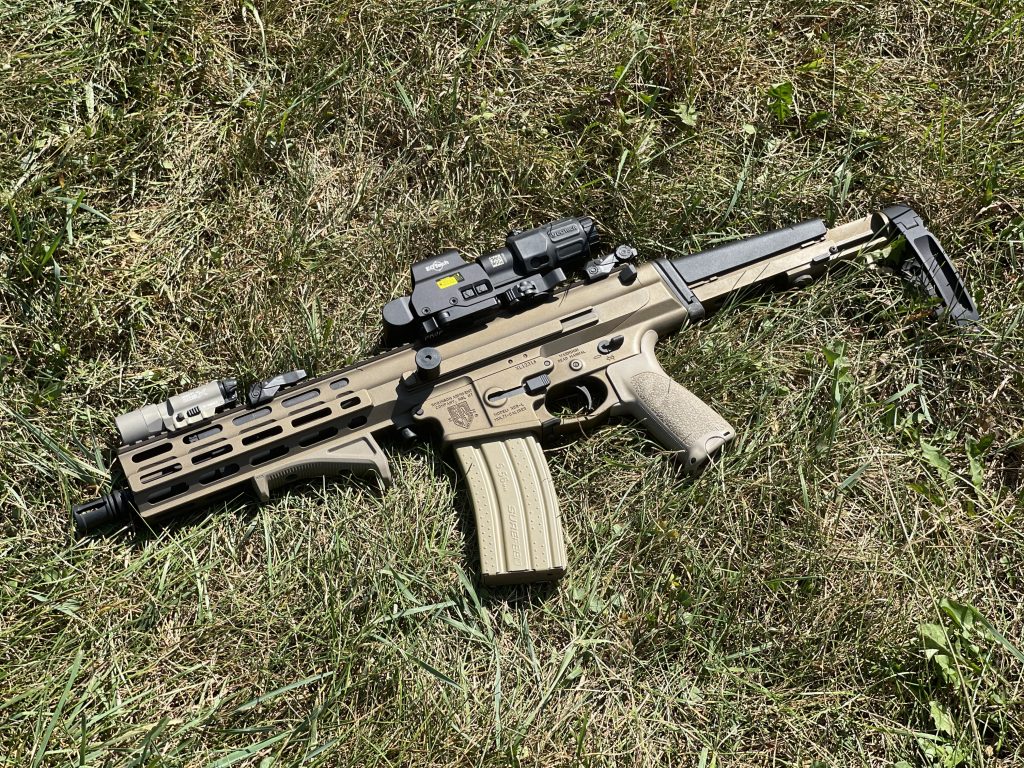
Holographic optics are a different breed. Their great strength is in their alignment properties and precision. The hologram can be fine tuned for a finer aiming point, and with less parallax to cause sight alignment issues, than red dots. This is done with a laser, and that laser eats up significantly more power than an LED. The projection housings are necessarily larger and more complex than red dots too in order to form the hologram.
Consequently the two leading holosights on the market, Vortex UH-1 Gen 2 and the EOTech line, are large optics. They match the profile of the Romeo8T we opened the article with and they have matching spatial constraints in their use.
But the precision of the optics, along with their more than satisfactory durability and maintenance, make EOTech make the list. The Vortex isn’t a bad option, but I like the lensing on the EOTechs better.
Specifically speaking about the EXPS models, the integral QD mounts hold the optic in the comfortable lower 1/3 ~38/39mm M4 height window. The optic has a short length thanks to the crossways CR123 power source, battery life is still a solid month of all day uses. They continue to hold contracts with SOCOM for several notable reasons.
If you need serious night vision compatibility, get the 3 model. If not or in a non-serious NODs use way, the 2 model is fine.
Fun Fact: “Non-NVG” model sights can still be used with NVGs, just set them on a very low brightness.
I can also say I still like the optical quality and feature set on the EOTech magnifiers best. This might factor into your dot selection too, but the EOTech goes very well behind any of the dots whether EOTech or otherwise.
Wildcard – Trijicon TA44 ACSS ACOG (Bonus TA50)
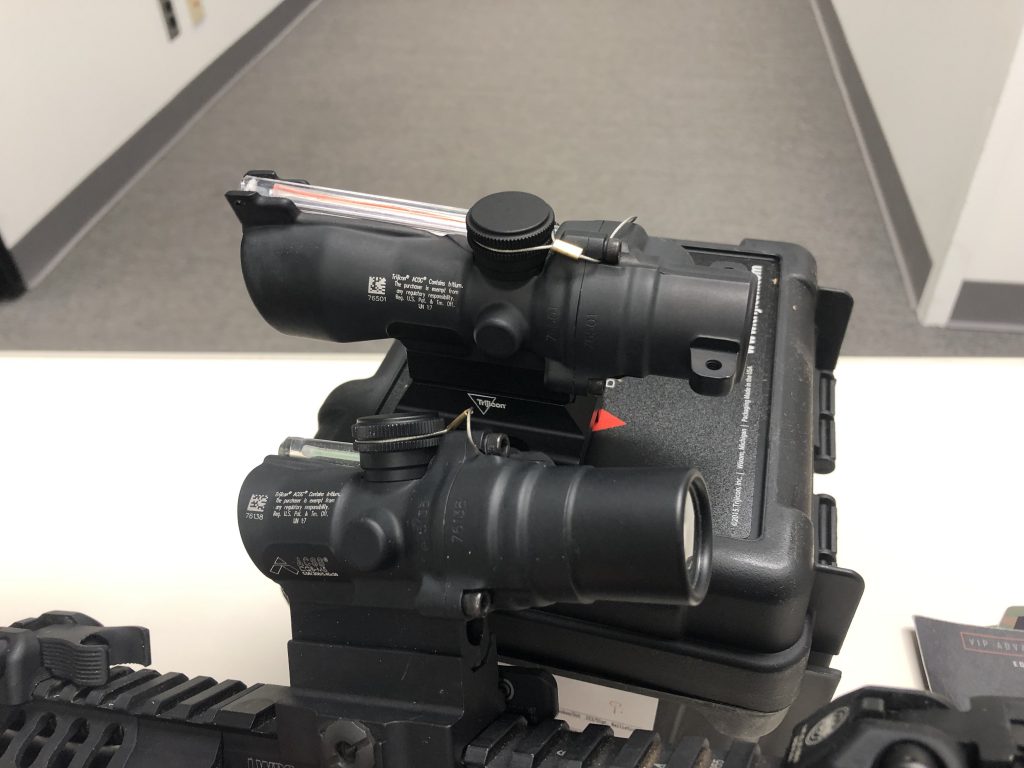
These aren’t red dots. But they occupy the role of red dot/red dot + magnifier.
The Gen2 Micro-ACOG line from Trijicon are an excellent place to look at if you need something with a solid state reticle. Their drawback is cost. There isn’t a model that doesn’t cost around $1,000, give or take. Primary Arms’ ACSS reticle system sharpens up the sight picture system a little more over some of the other reticle offerings, and provides the user with a little more flexibility in the control of their shot placement. These are durable, simple, and provide many of the advantages sought by red dot users while granting a few unique perks of their own. They are light, compact, and have solid state reticles that work with astigmatic eyeballs. Finally the ACOGs have fixed magnification, so no matter the model you take you are bringing the target image a little closer. 1.5x closer in the case of the TA44 and 3x in the case of the TA50.
I consider the TA50 a worthy successor to the TA11, a model used by the USMC on the M249 and M27 excellent results.
Again, these are not red dot optics but the serve in the same space and might fit a particular requirement you have for size, magnification, or reticle status.
Oh, and no batteries.



